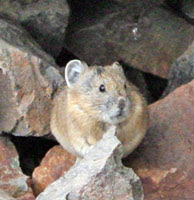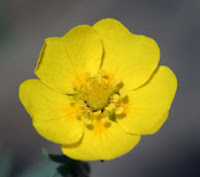The events described here actually occurred on July 14th.

 The Alpine Loop is probably the most famous four-wheel drive trip in the San Juan Mountains. It starts just south of Ouray on state 550, where a steep and fairly rugged track takes you up to timberline and then to Engineer Pass. This trip is a lot of fun as a four-wheeling trek, but wasn't much good for wildflowers. The pass itself is (yet another) place of incredible scenery, with rocky, snow-dotted peaks completely surrounding us, and beautiful valleys splayed out below us. The track then took us along Engineer Road to Lake City, 18 miles down a long gulch. The upper part of this was fairly good for wildflowers, though they were sparse compared to other routes we've taken. Our theory for this is that the eastern slope of the San Juan Mountains is the dry slope, though we don't actually know that for sure. At far right you can see Mo'i enjoying a romp at a stop along this path. He and Lea are really having fun with all the off-leash stops we've made. There are plenty of safe areas for this all along our path. After hitting Lake City, we headed south for the other leg of the loop, a long drive up to Cinnamon Pass. For wildflowers, this was very similar to the first leg — ok, but not great. Higher up, toward the pass, we found this little pika (photo immediately at right) peeking at us from under a snowbank right on the road. Our dogs went absolutely nuts upon spotting him.
The Alpine Loop is probably the most famous four-wheel drive trip in the San Juan Mountains. It starts just south of Ouray on state 550, where a steep and fairly rugged track takes you up to timberline and then to Engineer Pass. This trip is a lot of fun as a four-wheeling trek, but wasn't much good for wildflowers. The pass itself is (yet another) place of incredible scenery, with rocky, snow-dotted peaks completely surrounding us, and beautiful valleys splayed out below us. The track then took us along Engineer Road to Lake City, 18 miles down a long gulch. The upper part of this was fairly good for wildflowers, though they were sparse compared to other routes we've taken. Our theory for this is that the eastern slope of the San Juan Mountains is the dry slope, though we don't actually know that for sure. At far right you can see Mo'i enjoying a romp at a stop along this path. He and Lea are really having fun with all the off-leash stops we've made. There are plenty of safe areas for this all along our path. After hitting Lake City, we headed south for the other leg of the loop, a long drive up to Cinnamon Pass. For wildflowers, this was very similar to the first leg — ok, but not great. Higher up, toward the pass, we found this little pika (photo immediately at right) peeking at us from under a snowbank right on the road. Our dogs went absolutely nuts upon spotting him.

 The flower at far right is very common throughout our travels in the San Juans. I keep calling it a buttercup, as the bloom resembles one, but it's not really. We don't know exactly what it is. Some fields are so thick with these dime-sized blooms that even from a couple of miles away it looks like someone spilled yellow paint on the hillside. These are often one of the first things to bloom after the snow melts. The flower immediately at right is an Indian Paintbrush, a plant that can be parasitic (usually to nearby grass clumps). There are several colors of paintbrush in the San Juans. Most common are a sort of washed-out crimson, a yellow/greenish one, and a purple/pink one. This bright crimson variety, while common in our Southern California mountains, is a bit unusual here.
The flower at far right is very common throughout our travels in the San Juans. I keep calling it a buttercup, as the bloom resembles one, but it's not really. We don't know exactly what it is. Some fields are so thick with these dime-sized blooms that even from a couple of miles away it looks like someone spilled yellow paint on the hillside. These are often one of the first things to bloom after the snow melts. The flower immediately at right is an Indian Paintbrush, a plant that can be parasitic (usually to nearby grass clumps). There are several colors of paintbrush in the San Juans. Most common are a sort of washed-out crimson, a yellow/greenish one, and a purple/pink one. This bright crimson variety, while common in our Southern California mountains, is a bit unusual here.
As usual, click on the photos for a larger view.
